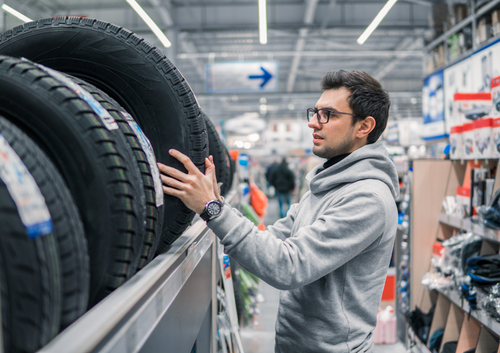Tire Buying 101: Everything You Want to Know
As someone who’s in their car quite a bit, you certainly understand the importance of having four quality tires. Beyond getting them rotated, you also make it a point to bring your car in as soon as you notice a nail or other damage to your tires.
But if you’re being completely honest with yourself, you’d have to admit your knowledge of tires ends about there. As for the rest of the world of tires — the differences between brands and determining which tires are best suited for your car — you could use some pointers.
No worries, though. Learning about tires and proper upkeep is not only important; it’s also pretty interesting. Check out the following mini-lessons:
Contents
What’s the Deal with Air Pressure?
If you think you can simply eyeball your tires to determine if their air pressure levels are dangerously low, please think again. Yes, an obviously squishy tire needs to be serviced, stat, but your tires can be underinflated and you might not know it without checking the pressure reading.
Underinflated or overinflated tires don’t wear evenly and usually don’t last long on the road, meaning you’ll have to spend your hard-earned money sooner than later to buy new ones. For instance, a tire that’s consistently 20 percent underinflated will last about 20 percent less than expected.
In the case of tires that are supposed to last 60,000 miles, you’ll be lucky to get 50,000 miles out of them. Additionally, underinflated tires are one of the biggest reasons why we burn more fuel than we should. And because underinflated tires have a higher rolling resistance, your car’s engine will have to work harder to compensate and get your vehicle moving.
To avoid these costly scenarios, check your tires’ air pressure at least once a month. If you find any tire is either overinflated or underinflated, you’ll want to address it right away. Finally, know that your car’s owner’s manual will include the correct tire pressure readings, so there shouldn’t be any mystery as to the right numbers.
Aren’t All Tire Brands Basically the Same?
In a word, “no.” While there are a number of different brands from which to choose, tires are definitely not a one-size-fits-all product. In the case of Nitto, the company is well-known for manufacturing high-performance tires with great aesthetics and handling.
In particular, Nitto’s focus is on tires for trucks, SUVs, luxury cars and sports cars. For example, the NT01 Specialty Ultra High-Performance Sport tire is an ideal choice for a sporty vehicle. However, if you drive a small hatchback, you would be better off with a different brand that’s designed for a lightweight vehicle.
How Do I Know Which Size Tires to Buy?
Just as you wouldn’t buy size 13 shoes for your size 10 feet, you don’t want to get the wrong size tires for your car. You can locate your car’s proper tire size on the interior of your door jamb or gas tank hatch, as well as on the tires themselves.
Each tire features a longtail code of numbers and letters; if you see a “P,” then that designates the tires are well-suited for a passenger car, while a code that features “LT” indicates these tires are for a light truck. The code also lets you know if the tire is a radial (“R”) or has bias construction (“B”). The rim diameter is also crucial to know, as it’s the width of the wheel from one end to the other and should always be replaced with tires with the same diameter reading.
Now You’re in the Know!
Because your tires have such an important job, it’s imperative you learn as much about proper care and handling as possible. By keeping tabs on your air pressure, realizing not all tire brands are created equal, and being cognizant about which tire size is ideal for your vehicle, you will become a much more educated tire owner and safer driver.




